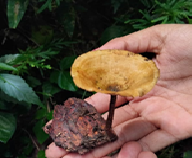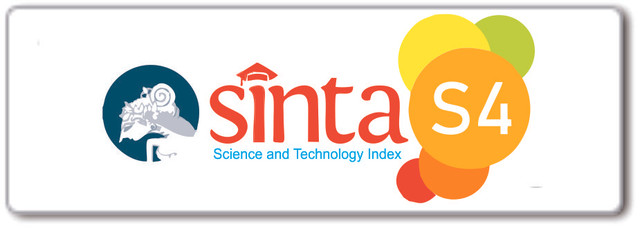Exploration of Fungal and Lichen Diversity in The Waitatiri Watershed, Central Maluku: Ecological Potential
Abstract
The Waitatiri Watershed (DAS) in Central Maluku is one of the tropical ecosystems that supports biodiversity, including fungi and lichens. Fungi play a significant role in organic matter decomposition, while lichens serve as bioindicators of air and environmental quality. However, information regarding the diversity of these organisms in the Waitatiri watershed remains limited. This study employed purposive random sampling to explore fungi and lichens in the Waitatiri watershed. Samples were collected from substrates such as living tree trunks, deadwood, bark, rocks, and soil. Initial identification was conducted using digital applications, followed by detailed identification based on relevant scientific literature. Data were analyzed descriptively to describe species types, distribution, and ecological roles. The study identified 10 fungal species from the phylum Basidiomycota and 7 lichen species from the phylum Ascomycota were identified, with foliose thalli and crustose thalli growing on living tree trunks, dead bark, and rocks. The presence of crustose lichens indicates relatively good air quality in the region. The diversity of fungi and lichens in the Waitatiri watershed highlights its importance as a local biodiversity habitat. Their ecological roles as decomposers and environmental bioindicators emphasize the need for watershed ecosystem conservation to ensure environmental sustainability. Further research is required to explore the ecological and economic potential of the identified species and support conservation efforts.
Downloads
References
A., Caceres, M. E., Fernando, L., & Dalforno, M. (2014). Rapid assessment of the diversity of “Vehiculicolous” lichen on a thirty year old ford bronco truck in Central Puerto Rico. Fungi, 22-27.
Boddy, L., & Watkinson, S. C. (1995). Wood decomposition, higher fungi, and their role in nutrient redistribution. Canadian Journal of Botany, 73(S1), 1377–1383. https://doi.org/10.1139/b95-400
Geethanjali, P. A., & Jayashankar, Prof. M. (2016). A Review on litter decomposition by soil fungal community. IOSR Journal of Pharmacy and Biological Sciences, 11(04), 01–03. https://doi.org/10.9790/3008-1104030103
Grimm, M., Grube, M., Schiefelbein, U., Zühlke, D., Bernhardt, J., & Riedel, K. (2021). The Lichens’ Microbiota, still a mystery? Frontiers in Microbiology, 12, 623839. https://doi.org/10.3389/fmicb.2021.623839
Hutasuhut, M. A., Febriani, H., & Devi, S. (2021). Identifikasi dan karakteristik habitat jenis lumut kerak di Taman Wisata Alam Sicikeh-Cikeh Kabupaten Dairi Sumatera Utara. Jurnal Biolokus, 4(1), 43. https://doi.org/10.30821/biolokus.v4i1.957
Kaswinarni, F., Ananda, T. T., & Rachmawati, R. C. (2023). Keanekaragaman jenis lichenes sebagai bioindikator kualitas udara di objek wisata Wono Sreni Indah Kota Jepara. Jurnal Ilmiah Teknosains, 9(2/Nov), 39–44. https://doi.org/10.26877/jitek.v9i2/Nov.16773
Madjeni, H. D., Bullu, N. I., & Hendrik, A. C. (2020). Keanekaragaman Lumut kerak (lichen) sebagai bioindikator pencemaran udara di taman wisata alam Camplong Kabupaten Kupang. Indigenous Biologi : Jurnal Pendidikan dan Sains Biologi, 2(2), 65–72. https://doi.org/10.33323/indigenous.v2i2.37
Mukherjee, S., & Ghorai, S. (2023). Fungal Biology. In Current Developments in Biotechnology and Bioengineering (hlm. 67–104). Elsevier. https://doi.org/10.1016/B978-0-323-91872-5.00017-X
Nailufa, L. E., Laelasari, I., Fitriani, M., & Paramadina, A. (2021). Morfologi tipe thalus lichen sebagai bioindikator pencemaran udara di Kudus. 3(1).
Nemet, F., Perić, K., & Lončarić, Z. (2021). Microbiological activities in the composting process: A review. Columella : Journal of Agricultural and Environmental Sciences, 8(2), 41–53. https://doi.org/10.18380/SZIE.COLUM.2021.8.2.41
Putra, D. A., Utama, S. P., & Mersyah, R. (2019). Pengelolaan sumberdaya alam berbasis masyarakat dalam upaya konservasi daerah aliran sungai Lubuk Langkap Desa Suka Maju Kecamatan Air Nipis Kabupaten Bengkulu Selatan. Naturalis: Jurnal Penelitian Pengelolaan Sumber Daya Alam dan Lingkungan, 8(2), 77–86. https://doi.org/10.31186/naturalis.8.2.9211
Rohim, R., Musthofa, M. H., Noerdin, I., & Supriatna, A. (2024). Morfologi Tipe thalus lichen sebagai bioindikator pencemaran udara di Taman Bundaran Cibiru Desa Cipadung Kecamatan Cibiru Kota Bandung. Polygon : Jurnal Ilmu Komputer dan Ilmu Pengetahuan Alam, 2(4), 96–104. https://doi.org/10.62383/polygon.v2i4.158
Roziaty, E., Sutarno, S., Suntoro, S., & Sugiyarto, S. (2023). Short Communication: The effects of SO2 and NO2 fumigation on the chlorophyll of Parmotrema perlatum from Mt. Lawu, Cemoro Sewu, Indonesia. Biodiversitas Journal of Biological Diversity, 24(5). https://doi.org/10.13057/biodiv/d240515
Supriati, R. & Helmiyetti. (2021). Lichens diversity of Kabawetan District Kepahyang, Regency Bengkulu Province: 3rd KOBI Congress, International and National Conferences (KOBICINC 2020), Bengkulu, Indonesia. https://doi.org/10.2991/absr.k.210621.037
Thakur, M., Bhardwaj, S., Kumar, V., & Rodrigo-Comino, J. (2024). Lichens as effective bioindicators for monitoring environmental changes: A comprehensive review. Total Environment Advances, 9, 200085. https://doi.org/10.1016/j.teadva.2023.200085

Copyright (c) 2025 Husnaini Bahri, Prelly M.J Tuapattinaya, Ritha Lusian Karuwal

This work is licensed under a Creative Commons Attribution-NonCommercial-ShareAlike 4.0 International License.
Authors who publish with BIOEDUPAT: Pattimura Journal of Biology and Learning agree to the following terms:
- Authors retain copyright and grant the journal right of first publication with the work simultaneously licensed under a Creative Commons Attribution License (CC BY-NC-SA 4.0) that allows others to share the work with an acknowledgment of the work's authorship and initial publication in this journal.
- Authors are able to enter into separate, additional contractual arrangements for the non-exclusive distribution of the journal's published version of the work (e.g., post it to an institutional repository or publish it in a book), with an acknowledgment of its initial publication in this journal.
- Authors are permitted and encouraged to post their work online (e.g., in institutional repositories or on their website) prior to and during the submission process, as it can lead to productive exchanges, as well as earlier and greater citation of published work.








 This work is licensed under a
This work is licensed under a 